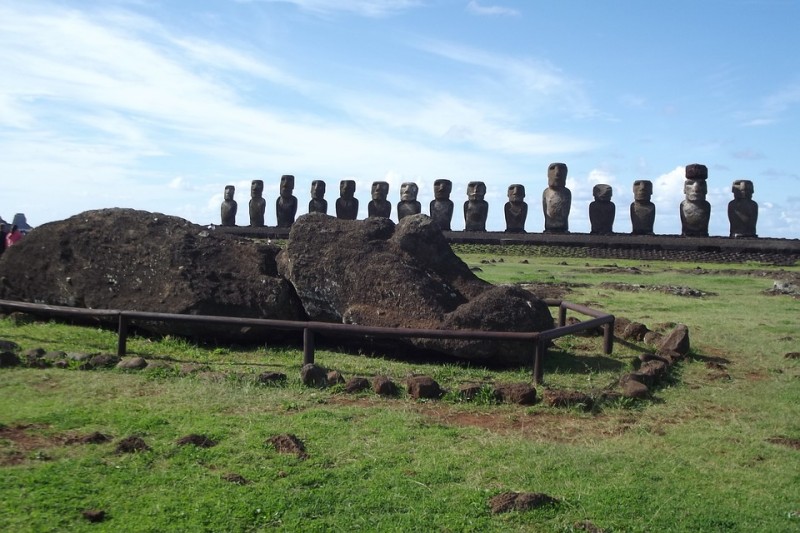
Easter Island, also known as Rapa Nui, is a remote island located in the Pacific Ocean. Despite its isolation, it has gained worldwide fame for its enigmatic and colossal stone statues known as Moai. These awe-inspiring structures have captivated the minds of historians, archaeologists, and tourists alike for centuries, leaving us with a myriad of questions about their origin, purpose, and the civilization that created them.
The History and Discovery of the Moai
The Moai were created by the indigenous Polynesian people who settled on Easter Island around 800 CE. The island's unique history and cultural heritage started unfolding when it was first discovered by Dutch explorer Jacob Roggeveen on Easter Sunday in 1722. The giant statues scattered across the island's landscape immediately caught the attention of the explorers, triggering curiosity and amazement.
The Giant Statues and Their Construction
The Massive Stone Monuments
The Moai are monumental human figures carved from volcanic rock. These statues are remarkable for their immense size, with some standing at over 30 feet tall and weighing several tons. Their distinctive, stern facial features and elongated ears are iconic symbols of Easter Island.
The Quarry and Transportation
One of the greatest mysteries surrounding the Moai is how the ancient Rapa Nui people managed to carve and transport these colossal stone figures from the quarry to various locations around the island. The quarries, known as Rano Raraku, served as the primary source of the stone used for sculpting the statues.
Theories on How the Moai Were Moved
Scholars have proposed various theories about the methods used to transport the Moai across the island. Some believe that they were rolled on logs, while others suggest the use of ropes and sledges. However, the precise technique remains a subject of ongoing debate and research.
The Rapa Nui Civilization and Culture
The Life of the Rapa Nui People
To truly understand the significance of the Moai, it's essential to delve into the history and culture of the Rapa Nui civilization. The Rapa Nui were skilled navigators and fishermen, relying on the island's resources to sustain their livelihoods.
Social and Religious Significance of the Moai
The Moai held deep religious and cultural importance for the Rapa Nui people. These statues were believed to embody the spirits of important ancestors and chieftains, acting as protectors and guardians of the community.
Decline of the Rapa Nui Civilization
Despite their ingenuity and cultural richness, the Rapa Nui civilization faced challenges that eventually led to its decline. Overpopulation, deforestation, and resource depletion are among the factors that contributed to the downfall of this once-prosperous society.
Unraveling the Mystery of the Moai
The Purpose of the Moai
The true purpose of the Moai has puzzled researchers for generations. Some theories propose that the statues served as a wayfinding system, guiding navigators across the vast ocean. Others suggest astronomical or agricultural significance.
Mysterious Faces and Symbols
The faces of the Moai display a mix of solemnity and mystery. Many statues also feature intricate carvings and symbols, which may hold clues to their intended purpose and deeper meanings.
Archaeological Investigations and Discoveries
Archaeological excavations and studies have shed light on various aspects of the Moai and the Rapa Nui civilization. Ongoing research continues to uncover new insights into the island's history and the engineering marvels of the statues.
Preservation and Challenges
Threats to the Moai
The Moai, like many ancient artifacts, face threats from environmental factors, tourism, and human activities. These challenges put the preservation of these iconic statues at risk.
Conservation Efforts
To safeguard the Moai for future generations, conservationists and local authorities have initiated efforts to protect and preserve these cultural treasures. Balancing tourism with preservation remains a delicate endeavor.
Moai in Pop Culture and Tourism
The enigmatic allure of the Moai has transcended time and found its place in popular culture. From movies to documentaries, books to video games, the giant statues of Easter Island continue to captivate the imagination of people worldwide.
The Moai of Easter Island stand as a testament to the ingenuity and creativity of the Rapa Nui people. While many mysteries still surround these massive stone figures, their significance as cultural icons and their role in shaping history cannot be denied. Preserving and understanding the Moai is a shared responsibility that allows us to connect with the past and learn valuable lessons for the future.
PM Modi, President honor Kargil bravehearts on Vijay Diwas
India's Defense Minister Declares Bold Stand: Ready to Cross LoC to Safeguard Honor and Sovereignty